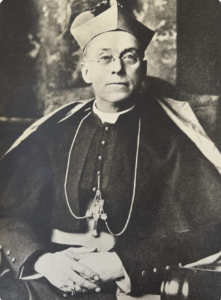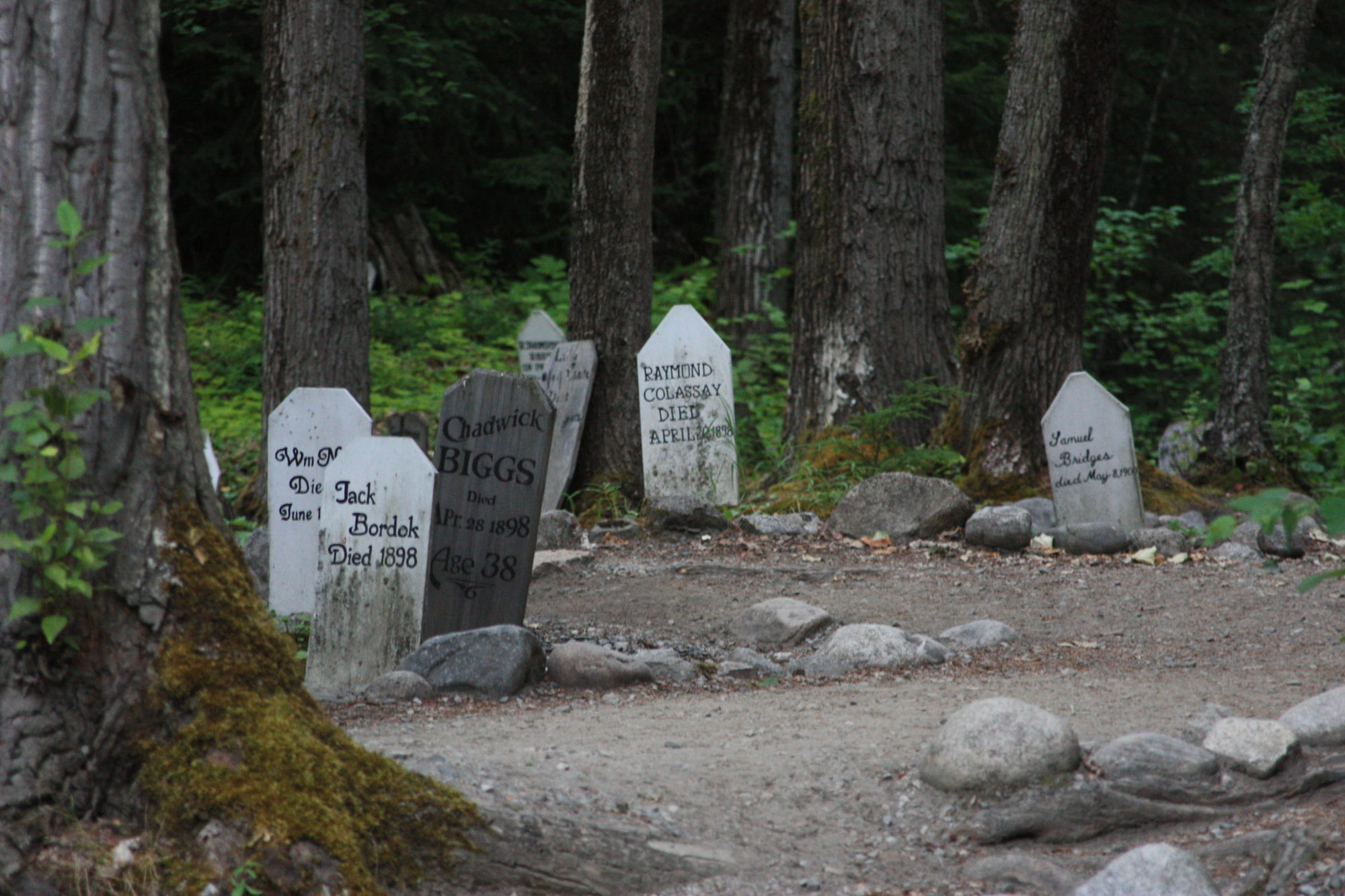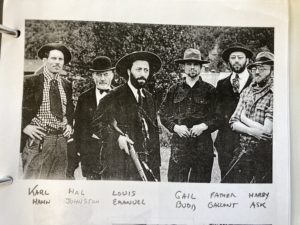Happy Birthday Mrs. Pullen!
Hattie Smith was born on this day, August 5, 1869 in Hope, Dane County Wisconsin. she married Mr. Pullen in 1880 and the clan moved to La Push Washington.
When the call of gold came, Harriet packed up and came to Skagway where she lived the rest of her life. She saw it all, horses that could not be off-boarded at Dyea – she jumped on their backs and rode them off through the water to the beach. She made pie tins out of flattened cans and started selling pies. With the money she made there she built a hotel that became the pride of Skagway, the Vanderbilts, President Harding and movie stars stayed there.
I first read of her in an article in Reader’s Digest in the 1960’s as one of their “Most Unforgettable Characters”. Quite a lady!
She died on August 8, 1947 in Skagway and is buried near her home on the east side of the railroad tracks.
Father George Edgar Gallant
Father Gallant was born in 1894 in Rustico, Prince Edward Island, Canada.
In 1898, during the Klondike gold rush stampede, Father Rene and Father Philibert Tumell, established Saint Mark’s Church in Skagway.
Young Father (later Monsignor) George Edgar Gallant, became the first priest ordained in Alaska on March 30, 1918. He came to Skagway in 1921 and built a new church and school here, which were named for Saint Theresa of the Child Jesus.
In 1931, Monsignor Gallant would establish Saint Pius X Mission Home for Native children who were either orphans or from destitute families, staffed by the Sisters of Saint Ann. It would be rebuilt in 1946, and would operate until the 1960s. Father Gallant stayed in Skagway until about 1929.
He was a Redemptorist Oblate and quite instrumental in encouraging and promoting the Redemptorists to establish a foundation in Alaska. He was a great devotee of Our Mother of Perpetual Help Devotions.
Monsignor Gallant died in 1975 back in PEI, Canada.  His Findagrave is 262426052. This picture was taken of him by Bessie Dedman in Skagway.
His Findagrave is 262426052. This picture was taken of him by Bessie Dedman in Skagway.
The church above is St Theresa’s on State Street and 9th Avenue, services on weekends year round.
Black Cross Rock
On this day, August 3, 1898 while working on the railroad track at Mile 13, there was a rockslide. A huge rock slid down and buried two workers, Maurice Dunn and Al Jeneux. I have never been able to find any record of those two men, but the story continues to this day by the train agents. At the time, Michael J. Heney decided that it would be too dangerous and costly to blow up the rock to recover the bodies so they were left in place. At first there were rumors that there were more bodies, but White Pass announced that there were only two and erected a small cross with the names there at the rock.
legends
Patrick Comer and John Stanley
On this day, August 2, 1903 two men went out fishing and never returned. They both drowned when they ran into trouble out in Lynn Canal. Patrick Comer was buried in the Skagway Gold Rush Cemetery but Mr. Stanley or Standley was shipped down to Seattle to be buried.
Stanley was the first Mayor of Skagway and joined the Arctic Brotherhood in 1899, he was 50 years old when he died. Comer was a fisherman and was 45 years old when he died.
Also died on this day was Herman Meyer, famous in this town for his building “Meyer’s Meat Market” which is now under reconstruction by the National Park Service on the corner of 5th and State Streets.
Meyer was a butcher, owned the Arctic Meat Company, and also managed the Arctic Telephone Company. He moved to Valdez in 1903 and died in Alaska on August 2, 1923.
Skagway death records; 1900 census; 1902 directory.
Walter and Winnifred Scott
Walter and Winnifred were twins born in Seattle in 1904, but they were baptised on this day, July 30, 1907 in the little church seen above in Carcross. Their parents were John Wallin and Mamie Emmerson Scott who moved to Carcross about 1903 and bought the Caribou Hotel from Walmsley there. Johns brother, Alfred helped them run it. John also worked as the town’s first postmaster. The hotel was known as the Scott Hotel and it burned in 1936.
Yukon Archives COR 275 f 6; Explorenorth
Martin Wilburn Tarwater
Mr. Tarwater was born in 1876 in Santa Rosa California. He came to Skagway in 1897 and was a friend of Jack London who was also from that part of the world.
Martin was reportedly a shoemaker and kept busy making and repairing shoes of the men who walked to the Yukon. Jack London wrote a story about “Old Man Tarwater” called “Like Argus in the Ancient Times” in his book The Red One.
London completely fictionalized his life and family to the consternation of his descendents.
Martin Tarwater died on this day, July 29, 1948 also in Santa Rosa.
Aunt Phil’s Trunk by Carlson p 233 online; descendents in Sonoma Co:Rootsweb posting
Vincent Tony Dortero
Antonio and Sabina Dortero were born in Italy and came to Skagway in the goldrush with their three children, John, Vincent and Rosie. Vincent was born in Astoria Washington on this day, July 28, 1894 but went to World War One where he died in 1918. There is a memorial across from the Skagway Museum/City Hall with his name and other names of war veterans.
Vincent was buried in the Pioneer Cemetery next to his father. Vincent was 24 years old when he died.
1915 directory; World War One registration; Cemetery record
photo of his father’s store online
 photo of Vincent, shortly before his death from influenza, from great granddaughter of John Dortero, Bettie Ogden.
photo of Vincent, shortly before his death from influenza, from great granddaughter of John Dortero, Bettie Ogden.
Robert Purves McLennan
Robert McLennan was a lumber businessman. He came to the area in 1899 and had lumber companies at both Atlin and Bennett. Although many stampeders built their own boats at Lake Bennett to float to Dawson, after the first few months, the nearby forests had been cut and it opened the opportunity for boat builders and lumber companies to operate.
McLennan was born in Pictou, Nova Scotia in 1861, and he died on this day July 27, 1927 in Vancouver.
The picture above is of a steam powered lumber mill. Another lumber company, owned by Albert Kerry packed a steam engine over the Chilkoot Pass to set up at Lake Bennett. Kerry and his brothers later used the engine to build their own boat and go to Dawson.
These steam engines were very dangerous and had a nasty habit of exploding at the worst moment. Reed’s g-grand uncle, John McCluskey was killed by one in 1868 in Owaneco, Illinois. This was after he had survived 4 years of the Civil War.
from the Dictionary of Canadian Biography online; personal genealogy story
Orin Howard Babcock

Born on this day, July 26, 1874 in Aurora Illinois, Orin moved to Port Angeles and ran a dairy there, he later operated a large dairy farm in Eden Valley.
In 1898 he joined the throngs of goldrushers and came to Skagway.
He moved back to Ellensburg, Washington where he died in a car accident on Christmas Day 1948.
His great grandfather Orin Babcock was from New York and was coincidentally distantly related to my husband’s side of the family, the Babcocks of New York.
Isn’t genealogy fun? Here is a picture of the proud family coat of arms.
Olypen.com Pioneer obituaries
John Harte McGraw
Born on October 4, 1850, in Penobscot County, Maine, John McGraw arrived in Seattle in 1876 broke and friendless. While growing up in Maine, McGraw’s father drowned, his mother remarried, and he found himself running a general store at age 17. He arrived in Seattle from Maine during the 1870s at the age of 26, and got a job as a clerk in the Occidental Hotel. He joined Seattle’s tiny police force and that was the beginning of his successful Pacific Northwest career in law enforcement, business, and politics.
John McGraw’s Seattle police job was occasionally exciting. Those young years, the wide-open town saw the toleration of a certain level of lawlessness. On January 17, 1882, businessman George B. Reynolds was threatened by two armed men as he walked down the street. Reynolds refused to cooperate with the robbers and was fatally shot in the chest. Reynold’s murder aroused Seattleites who caught the suspects and turned them over to authorities.
A mob formed, demanding custody of the accused. Seattle Chief of Police McGraw and King County sheriff Lewis Wykoff (1828-1882), both of whom were armed, held firm, but the next morning at the preliminary hearing the mob grabbed the prisoners and hanged them from two maple trees in Occidental (Pioneer) Square. Then they returned to the jail, extracted another prisoner, and hanged him as well. (Wykoff died suddenly of heart disease two days later.)
John McGraw ran for governor in 1892 with the slogan “Build the Lake Washington Canal and Build it for 1893.” (Ground was broken for the canal in 1911 and it opened for navigation on May 8, 1917.)
During his term as governor, McGraw was considered “a zealous friend of the University of Washington,” leading the effort to purchase a tract of land for $28,313.75 that became catalyst for the future campus. The cornerstone of the first building was laid during ceremonies on July 4, 1894.
Similar to many Pacific Northwesterners, McGraw was bitten by the “gold bug” following the July 17, 1897, arrival from Alaska of the steamship Portland with its “ton of gold.” Following his term as governor, and a spell of ill health, McGraw headed north as a first class passenger aboard the famous Portland on her return trip to Alaska. He arrived in Skagway in 1897. In 1900, he returned without striking it rich, but wiser and in better health.
John McGraw died on this day, July 23, 1910 in Seattle. After his death, a bronze statue of him, made in Paris by sculptor Richard E. Brooks, was erected in Seattle’s Times Square.
Historylink.org







